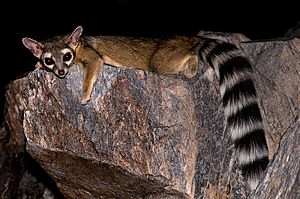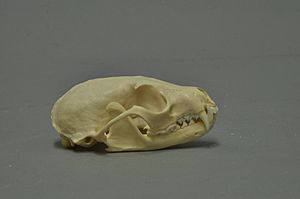Ringtail facts for kids
Quick facts for kids Ringtail |
|
|---|---|
 |
|
| Ringtail in Phoenix, Arizona | |
| Conservation status | |
| Scientific classification | |
| Genus: |
Bassariscus
|
| Species: |
astutus
|
| Subspecies | |
|
|
 |
|
| Ring-tailed cat range | |
The ringtail (Bassariscus astutus) is a small mammal that belongs to the raccoon family. It lives in dry areas of North America. This animal is very common and can live well even in places changed by humans. It is listed as "Least Concern" on the IUCN Red List, which means it is not currently in danger of disappearing.
People call the ringtail by many different names, like ring-tailed cat, miner's cat, civet cat, and cacomistle. The ringtail is also the official state mammal of Arizona.
Contents
Description
The ringtail's fur is black to dark brown on its back and sides, with lighter fur on its belly. It has a pointy nose with long whiskers, much like a fox. In fact, its Latin name means 'clever little fox'! Its body shape is similar to a cat's. Dark fur around its eyes makes its face look like it's wearing a mask.

One of the ringtail's most special features is its long tail. It has 14 to 16 black and white rings, making it look striped. This tail is about the same length as its body!
Ringtails are mostly active at night, which means they are nocturnal. They have large eyes and ears that stand up, helping them see and find food in the dark. They are amazing climbers and use their long tails to keep their balance. The rings on their tail can also trick predators. If a predator grabs the tail instead of the body, the ringtail has a better chance to escape.
Their claws are short, straight, and can pull back a little bit. These claws are perfect for climbing. Ringtails are smaller than a regular house cat. Their body is about 30 to 42 centimeters (12 to 17 inches) long, and their tail is about 31 to 44 centimeters (12 to 17 inches) long. They usually weigh around 0.7 to 1.5 kilograms (1.5 to 3.3 pounds).
The ringtail's ankle joints are very flexible. They can turn more than 180 degrees! This helps them be very agile climbers. Their long tail helps them balance when walking on narrow ledges or tree branches. They can even turn around quickly by doing a cartwheel! Ringtails can also climb up narrow spaces by pushing their feet on one wall and their back against the other. For wider cracks, they bounce between the walls.
Adult ringtails usually live alone. They only come together to mate. They make a variety of sounds, including loud barks, clicks, and chattering noises, similar to raccoons. Ringtails also use their poop to mark their territory. This helps them communicate with other ringtails about who lives where.
Ringtails prefer to be by themselves but sometimes share a den or groom each other. They don't interact much, except during the breeding season in early spring. Ringtails can go a long time without drinking water. They get most of the water they need from the food they eat. This helps them survive in dry places.
Reproduction
Ringtails mate in the spring. The mother ringtail carries her babies for about 45 to 50 days. During this time, the male ringtail will bring food to the female. A mother ringtail usually has 2 to 4 babies, called kits, in one litter. The kits open their eyes after about one month. They learn to hunt for themselves when they are about four months old. Ringtails can have their own babies when they are 10 months old. In the wild, a ringtail usually lives for about seven years.
Range and habitat
Ringtails often live in rocky desert areas. They make their homes in hollow trees or old wooden buildings. You can find them in the Great Basin Desert, which covers parts of Nevada, Utah, California, Idaho, and Oregon. They also live in the Sonoran Desert in Arizona, and the Chihuahuan Desert in New Mexico, Texas, and northern Mexico. Ringtails also like rocky places near water, such as canyons, caves, or old mine shafts.
In places with lots of water, you might find many ringtails living close together. A male ringtail's territory can be about 50 to 100 acres (20 to 40 hectares) and might overlap with the territories of several females.
Ringtails live in the southwestern United States, including southern Oregon, California, eastern Kansas, Oklahoma, Arizona, New Mexico, Colorado, southern Nevada, Utah, Louisiana, and Texas. In Mexico, they live from the northern desert state of Baja California all the way to Oaxaca.
Diet
Ringtails are omnivorous, which means they eat both plants and animals. During winter, they mostly eat small animals like birds, rats, mice, squirrels, rabbits, snakes, lizards, frogs, and toads.
However, throughout the year, berries and insects are also very important parts of their diet. In spring and summer, fruits and insects become their main food. They enjoy a wide variety of foods. Besides insects and small mammals, they sometimes eat fish, birds, and even dead animals (carrion). Ringtails also love fruits like juniper berries, hackberries, black berries, persimmons, and prickly pear. They have even been seen eating birdseed or drinking sweet nectar from hummingbird feeders!
Ecology
Many animals hunt ringtails, especially the younger ones. These predators include Foxes, coyotes, raccoons, bobcats, hawks, and owls. Sometimes, coatis, lynxes, and mountain lions also prey on them. However, ringtails are quite good at avoiding danger. They can spray a strong-smelling musk when they are scared or threatened, which helps them get away. The main predators of the ringtail are the great horned owl and the red-tailed hawk.
People used to hunt ringtails for their fur, but their fur is not very valuable. Hunting for their fur has greatly decreased.
Tameability
Ringtails are known to be easy to tame and get used to humans. They can become loving pets and are very good at catching mice and other pests. Long ago, miners and settlers kept pet ringtails to keep their cabins free of unwanted animals. This is why they were often called "miner's cats."
Images for kids
See also
 In Spanish: Cacomixtle para niños
In Spanish: Cacomixtle para niños







